Looking for the safest disposable diapers for your baby? Here are the top non-toxic diapers!
When it comes to choosing a diaper, it’s important to choose the very best brand for your baby. This will entail some trial-and-error as you find a diaper that fits your baby and doesn’t leak. But another incredibly important aspect to consider is, What is that diaper made of?
While many diapers are made at the same manufacturing plants in China or Mexico, not all diapers are created equal. Some are incredibly unhealthy, and others are made responsibly with clean materials and ingredients.
In fact, many disposable diapers on the market contain materials and chemicals that could potentially lead to rashes or irritation, allergies, asthma, developmental delays, and longer-term health issues. Considering how diapers are worn constantly and how delicate a baby’s skin is, these products must be avoided.
It’s so important to choose your baby’s diaper carefully. Not only will your baby be wearing a diaper around the clock, but the materials in the diaper make direct contact with your baby’s skin.
Given that your baby will spend a significant portion of their early development years wearing diapers, it’s essential to choose the healthiest diaper for your little one.
While disposable diapers are far from perfect, I am happy to report that there are several safer brands for you to choose from. In this article, I’ve compiled a list of safer disposable diapers for babies and outlined what you should look out for when buying non-toxic disposable diapers.
What Are Diapers Made Of?
Disposable diapers are pretty complex in their design. They require multiple layers and materials to absorb liquids and keep your baby comfortable between diaper changes. Diapers can be made from various materials, many synthetic, each chosen for specific properties like absorbency, comfort, and durability.
Here’s a breakdown of typical components found in most diapers:
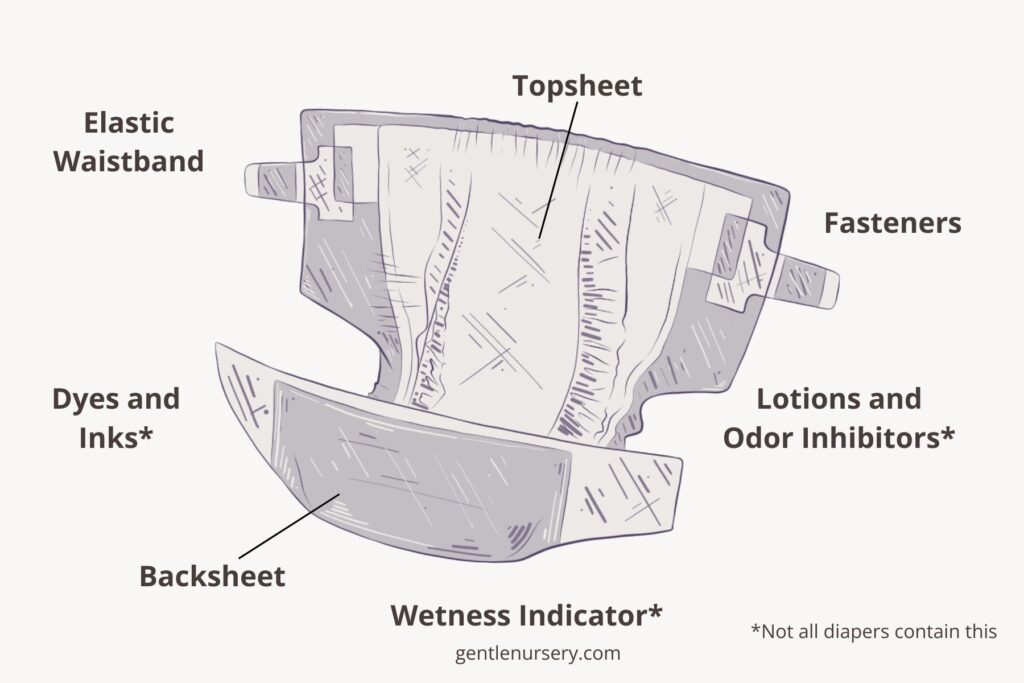
- Topsheet (Inner Lining): Made from non-woven fabric, this layer makes direct contact with the baby’s skin and is designed to allow fluid to pass through while feeling dry. Topsheets can be made from cotton, polyester, bamboo-nylon, or a polyester-rayon blend.
- Absorbent Core: The core is crucial for absorbing and retaining liquids. In disposable diapers, it usually consists of Super Absorbent Polymer (SAP), often sodium polyacrylate, which can hold many times its weight in liquid. The core might also contain fluff pulp, made from wood.
- Backsheet (Outer Layer): The backsheet is typically made of a waterproof material like polyethylene film or a cloth-like waterproof exterior. It’s designed to prevent liquids from leaking out of the diaper. Some brands have logos or designs on the outside of their diapers, while others are just plain white.
- Elastic Elements: Elastics around the waist and leg openings provide a snug, comfortable fit. These can be made from synthetic rubber or spandex.
- Fastening System: Traditional disposable diapers use strips of a hook-and-loop or adhesive material similar to Velcro for closures.
- Wetness Indicator: Many disposable diapers include a wetness indicator, usually a strip that changes color when wet, made from a dye that reacts to moisture. These can contain ingredients of concern.
- Dyes, Fragrances, and Lotions: Some diapers contain dyes or inks used for patterns and colors. Some also contain lotions or aloe vera linings to help protect the baby’s skin. And some diapers contain fragrances, lotions, or odor inhibitors that can also be problematic and unhealthy.
It’s important to note that materials can vary significantly from one diaper brand to another, and that’s a large part of what goes into choosing a non-toxic disposable diaper.
But, let’s address the elephant in the room.
Diaper manufacturers are not required to disclose all of their ingredients, and some companies won’t even tell you what is in their diapers. That’s a BIG red flag 🚩 that tells me that some diaper brands may contain even more harmful ingredients than we realize.
The good thing is that more and more companies are starting to voluntarily disclose their ingredients, but not all are doing this. Even when they do, some brands are being deceptive or just not telling us the full story.
What Makes a Diaper Toxic?
Diapers can be toxic and unhealthy in a number of ways, from the fabrics and materials used in making the diaper, to where the diaper itself is manufactured. Here are some things to look out for:
❌ PFAS Found in Diapers
Do we need to be concerned about perfluorinated chemicals in diapers? Yes, sadly.
PFAS are forever chemicals that are associated with a number of health issues, and the biggest issue is that they are persistent. This means that they build up in the body and are difficult to expel. They are also found in the environment.
Mamavation conducted a consumer study on PFAS in cloth and disposable diapers, and the results were shocking.
- 23% of products tested had indications of PFAS.
- 17% of disposable diapers tested had indications of PFAS.
- 30% of reusable cloth diapers & accessories had indications of PFAS.
And it wasn’t just a matter of mainstream vs. modern brands. This issue affects diaper brands across the board, as Mamavation tested 65 products from a mix of brands (healthy and mainstream). In many instances, the problem likely stems from a manufacturing issue, not a material choice.
But the bottom line is: avoid any diaper brand that tested high for indications of PFAS, and choose a safer diaper that tested clean.
❌ Chlorine, Derivatives, and Dioxins
Disposable diapers were traditionally made using wood pulp bleached with elemental chlorine. This process is toxic and results in a byproduct called dioxins.
Dioxins are a class of highly toxic chemicals that accumulate in your body and can wreak havoc on the immune system. Dioxins are highly carcinogenic and they are also known to cause allergic skin reactions and skin irritations.
Thanks to growing concerns over the byproducts of chlorine bleaching, government regulations in the 1990s eliminated wood pulp bleached with elemental chlorine. As a result, two safer bleaching methods have become the standard in wood pulp bleaching used in disposable diapers:
- ECF: elemental chlorine-free pulp. [Not recommended] You’ll now find diapers that are marketed using ECF pulp, which means that elemental chlorine is not used. However, the pulp is bleached with chlorine dioxide, which is a chlorine derivative and itself is a hazardous substance. This process reduces dioxins, but it believed that it does not fully eliminate them and simply that some testing mechanisms may not be able to detect their presence. Since the data is inconclusive, and chlorine dioxide is still a derivative of chlorine, I prefer to avoid ECF when possible. This process is safer than bleaching with elemental chlorine, but I do not recommend elemental chlorine-free diapers if and when there are better alternatives available.
- TCF: total chlorine-free pulp. TCF is a bleaching process that does not use chlorine or chlorine derivatives. It is a much safer process because it uses oxygen, peroxide, or ozone-based bleaching systems. These methods are safer than using chlorine because they do not generate dioxins. This is the safest bleaching method you’ll find being used in diapers at this time. Always look for TCF (total chlorine-free) pulp when possible.
More and more brands are switching from TCF to ECF such as Millie Moon and Honest Company. Whenever reasonable, try to use a brand of diaper that is TCF. We don’t fully know the implications of ECF at this time.
NOTE: Don’t fall for technicalities or greenwashing. It is NOT enough for a company to call their diapers “chlorine-free” or “elemental chlorine-free” because they may be claiming that it does not contain elemental chlorine while it does contain chlorine dioxide. Always look for pulp that is explicitly TCF total chlorine-free.
❌ Fragrances, Lotions, and Phthalates
Fragrances, odor inhibitors, and lotions are all used in many disposable diaper brands.
Anytime a company lists “fragrance” in their list of ingredients, it means they are not disclosing the full list of ingredients in their fragrance due to a loophole in the law that allows for the protection of trade secrets.
Synthetic fragrances may contain phthalates, which are known endocrine disruptors. Using products that contain a nondescript “fragrance” or even an odor inhibitor puts your baby’s skin in direct contact with these chemicals and puts them at risk of rashes, skin irritation, allergic reactions, and other health hazards.
⁉️ Sodium Polyacrylate: Can It Be Avoided?
As far as I can tell, all disposable diapers contain sodium polyacrylate (SAP) because this is the material that makes diapers absorbent. If you have ever had a diaper break apart after a leak, you may have noticed sodium polyacrylate as small gel-like crystals on your baby’s skin. (By the way, you should discontinue using any diapers that leak gels/crystals onto your baby’s skin — and ask the company for a refund.)
Sodium polyacrylate is believed to cause skin irritations and may or may not be a health hazard. It is the same chemical found in tampons that was linked to Toxic Shock Syndrome in women in the 1980s, though this may have been because women left the tampons in too long and created a breeding ground for bacteria.
Sadly, however, I have found that all disposable diapers contain some form of SAP, including eco-friendly and non-toxic diapers. Many also contain layers made with plastic that will also come in contact with your baby’s skin. If you are able to use cloth diapers, this is the best way to avoid SAP and plastic-based ingredients.
❌ Other Chemicals to Avoid
Here’s a shortlist of other chemicals of concern commonly found in diapers:
Tributyltin. Another chemical found in many disposable diapers is tributyltin or TBT. This chemical is known to be extremely harmful to water life and may also cause skin problems in humans.
VOCs. Disposable diapers commonly contain volatile organic compounds (VOCs), which are chemicals that have a high vapor pressure at room temperature. The VOCs commonly found in disposable diapers include such chemicals as toluene, ethylbenzene, and xylene. These chemicals can evaporate and cause impaired immune function and damage to the liver, kidneys, respiratory system, and lungs.
Best Non-Toxic Disposable Diapers
To avoid these harmful ingredients, choose disposable diapers that are made with safer materials. These diapers are safer than mainstream diaper brands because they use less harmful chemicals and materials, and provide:
- Reduced risk of irritation and diaper rash
- Reduced risk of allergic reaction
- Reduced exposure to harsh chemicals and fragrances
While there is no perfect disposable diaper on the market, this list should provide enough reasons to forgo using mainstream diapers. And the best thing is that non-toxic diapers are just as effective and absorbent as mainstream diapers, and sometimes equally cost effective.
Here are the best non-toxic diapers! These diapers are made with cleaner materials, do not contain any fragrances or lotions, and tested clean in Mamavations study on PFAS in diapers. For these important reasons, they are our top recommendations for non-toxic diapers.
Healthybaby Diapers
Made with organic cotton and Oeko-Tex certified materials, Healthybaby (formerly Healthynest) tops our list of the best non-toxic disposable diapers. Featuring a plant-based inner and outer layer, all materials that your baby makes contact with are plant-based. Healthynest’s diapers are free of chlorine, dioxins, phthalates, fragrances, and parabens. Their diaper tested well in Mamavation’s study on PFAS in diapers.
Given their use of organic cotton and plant-based materials, as well as testing clear for indications of PFAS, Healthynest diapers are my top choice for the best disposable diapers. They are also wonderful for babies with sensitive skin, highly absorbent and great for overnight use too.
I also like that these diapers are EWG-verified because that indicates the company is transparent about their manufacturing process. This is a big factor in making them our top recommendation. Highly recommend!
- Sizes: Available in sizes 1-6. Approximately 6 lbs. to 37+
- Topsheet: Plant-based
- Mamavation study: Passed ✅
- Where to order Healthybaby diapers:
- Available at Target stores nationwide
- Order Healthybaby Diapers directly through the company website
Freestyle Diapers
A unique option for a non-toxic diaper, Freestyle Diapers use a BambooTek core instead of fluff pulp. This makes them neither TCF nor ECF, and a good option to consider for your baby. These diapers are highly absorbent and parents rave about how soft they are.
Freestyle Diapers are available in sizes 1-6 for 8-35+ lb weight range. Since their smallest diaper begins at 8 lbs., they might not the best fit for a newborn or preemie baby.
- Sizes: Available in sizes 1-6. Approximately 8-38+ lbs.
- Mamavation study: Passed ✅
- Topsheet: Plant-based
- Freestyle Diapers are available at:
- Amazon
- On the Freestyle website for subscription orders
- Whole Foods and other premium grocers
Kudos Diapers
Made with a cotton topsheet sourced from cotton farms in the United States, Kudos Diapers are engineered to prevent synthetic materials from making direct contact with your baby’s skin. With super soft materials and two absorbent layers, Kudos is a great choice for your baby’s non-toxic diaper.
They’re available in sizes 1-6 for a 7-30+ lb. weight range. The diapers run a little small compared to other brands (FYI) and come in two cute prints as well as a plain white version.
- Sizes: Available in sizes 1-6. Approximately 7-30+ lbs. Runs small.
- PFAS Status: Kudos did not pass the Mamavation study testing (two size 4 diapers failed, and one size 5 diaper tested clean). But the brand later conducted PFAS testing independently and shared negative test results. (Please note that these are not necessarily tested at the same lab or with the same detection limits.)
- Topsheet: Cotton sourced in the USA
- Kudos Diapers are available on their website
Coterie
Coterie diapers are known for being super soft and highly absorbent. They use a special fabric webbing technique that gives the diapers a unique garment-like feel. The diapers are TCF total chlorine-free and made with wood from sustainable forests. These diapers are “okay” in the sense that they are TCF but the backsheet is made from polypropylene and polyester.
However, I’ve had a lot of readers use and love Coterie and they make the list for being TCF and being made without fragrances, phthalates, dyes, and parabens.
- Sizes: Available in sizes N-6. For under 10 lbs to 35+ lbs.
- Mamavation study: Passed ✅
- Topsheet: Synthetic material
- Coterie is available at:
- On the Coterie website for one-time purchase or auto-renew subscription
- At Whole Foods stores nationwide
Andy Pandy Premium Bamboo Diapers
Andy Pandy disposable diapers are chlorine-free, biodegradable, and eco-friendly. They contain no phthalates, BPA, PVC, alcohol, TBT, or preservatives. Andy Pandy diapers use an aloe liner to moisturize baby’s skin and are breathable to help circulate air and keep baby’s bottom dry. You’ll also notice a wetness indicator like you’ll find in many mainstream brands. A yellow line on the front will turn green when it’s time for a diaper change. (This is a very helpful feature for the newborn stage when you will need to count wet diapers right after your baby is born.)
The company has also confirmed that they do not use any GMO materials and their diapers have been tested to not contain heavy metals. Andy Pandy diapers are a great option for non-toxic disposable diapers.
- Sizes: N-XL, 7-26 lbs. +
- Mamavation study: Passed ✅
- Topsheet: Plant-based
- Andy Pandy diapers are available on Amazon
ABBY & FINN Diapers
ABBY & FINN diapers are made with TCF
However, these diapers are made using polypropylene, polyethylene film, and polyester. If you are trying to avoid most synthetic materials, you’ll want to stick with a different brand of non-toxic diapers listed here.
- Sizes: 1-7 for 8-38+ lbs. These diapers run narrow compared to some brands.
- Mamavation study: Passed ✅
- Topsheet: Synthetic material
- Abby & Finn is available through Amazon
EcoBoom
If you prefer bamboo diapers, EcoBoom is another great choice. The topsheet and bottomsheet are made from bamboo viscose and the pulp is TCF total chlorine-free. These diapers are pretty similar to Dyper and Andy Pandy, and they also have a wetness indicator at the front. They are very absorbent and great for overnight.
- Sizes: 0-5 for under 7 lbs. to 26+ lbs.
- Mamavation study: Passed ✅
- Topsheet: Plant-based
- EcoBoom is available through:
Seventh Generation Diapers
Thanks to Mamavation’s study on PFAS in diapers, Seventh Generation makes our list of the best non-toxic diapers for the first time. Their diapers have improved over the years, and we’re thrilled to see them test well on fluorine.
While the inner topsheet is made from polypropylene, these diapers are fragrance-free and highly absorbent. The company also indicates that the dyes used are free from heavy metals.
- Sizes: N-6 for under 10 lbs. to 35+ lbs.
- Mamavation study: Passed ✅
- Topsheet: Synthetic material
- Seventh Generation diapers are available at
Better Non-Toxic Disposable Diapers
This group of diapers was tested by Mamavation and showed no indications of organic fluorine. They make our Better list simply because some of the materials aren’t as ideal as our “Best” options. For example, these diapers use ECF instead of TCF processing.
Dyper
Similar to Andy Pandy diapers, Dyper is made from viscose fibers sourced from bamboo. They don’t have any designs or patterns so you don’t have to worry about any questionable dyes being used.
The diapers (
Perhaps the best thing about Dyper is that the entire diaper is Oeko-Tek certified. Unlike other brands that indicate they are Oeko-Tek certified but merely use certified materials, Dyper has a full certification for the final product.
To order Dyper, you would sign up for a monthly diaper subscription. The nice thing about this is that you can set it and forget it and Dyper will adjust your subscription using predictive modeling to estimate the size and quantity of diapers your baby needs based on their age. If they get it wrong or you simply need more diapers, they’ll send you a replacement – and it’ll arrive sometimes as fast as only a few hours.
You can also manage your subscription through Dyper’s mobile apps. If you happen to be on vacation, for example, Dyper can also send you an extra shipment to your hotel or Airbnb.
- Mamavation study: Passed ✅
- Topsheet: Plant-based
- Dyper is available through:
- Amazon
- Dyper’s website direct (subscription or one-time orders)
Eco by Naty Diapers
Eco by Naty diapers are also a great pick when you’re looking for natural diapers because they contain no phthalates, organotins (MBT, DBT, TBT), allergens, carcinogens, heavy metals, chlorine, formaldehyde, colophonium, dyes, PVC, GMOs, dioxins, or any substances known to be harmful. They were TCF but are now ECF but the company has indicated there are no dioxins to worry about.
Naty diapers also don’t have any fragrances or perfumes so you don’t need to worry about skin reactions caused by questionable fragrance ingredients.
Eco by Naty Diapers are certified by the Swedish Society for Nature Conservancy, and are made from more than 60% natural biodegradable materials. Please note that they are made using cornstarch, which can be a potential allergen to the most sensitive of babies.
Developed in Sweden and made in Turkey, Naty Diapers are known for being absorbent and having a great fit.
Millie Moon
Sold exclusively at Target, Millie Moon diapers are a great choice for parents who prefer to buy their diapers in-store. Millie Moon diapers are ECF and are also made with Oeko-Tex certified materials.
In 2023, Millie Moon switched to ECF, which has caused some babies to react to their new formulation. If these diapers still work for your baby, there is little to be concerned with in my opinion. Keep using them if they work for you, and if not, or if you’d prefer to avoid ECF, then switch to one of the ECF diapers listed above.
However, please note that these diapers are made with polypropylene nonwoven fabrics and polyethylene film. So if you’re set on choosing a diaper with a cotton topsheet, this is not the right choice for you. But if you’re looking for something relatively cleaner and easily accessible at your local Target, Millie Moon is a good choice — even as just an occasional backup.
- Mamavation study: Passed ✅
- Topsheet: synthetic material
- Millie Moon is exclusively available at Target
Ecoriginals Plant-Based Diapers
EcOriginals, originally an Australian brand, makes a high-quality non-toxic disposable diaper. The only materials your baby will make contact with are the cotton topsheet, cotton leg cuffs, and non-GMO cornstarch. EcOriginals is focused on being a sustainable diaper brand and even their packaging is made from paper and is recyclable.
The diapers themselves are free from AZO dyes (love this), formaldehyde, heavy metals, and are total chlorine free. These diapers are absorbent and more than 90% biodegradable.
Honest Clean Conscious Diapers
Though I don’t use many Honest Company baby products, their diapers are well-made and absorbent. However, their diapers have gone through many changes and have been reformulated to be less plant-based and more petroleum-based over the years. Honest Company diapers were reformulated in 2018, and now the inner layer is made from polyethylene and polypropylene, which is unfortunate since they previously used a plant-based PLA inner layer. So, please note that your baby will come in direct contact with these plastic-based materials.
In November 2023, Honest Company switched from TCF to ECF processing. Overall, Honest Diapers are still a good and reliable choice, but I wish they would have kept their TCF pulp in place.
- Mamavation study: Passed ✅
- Topsheet: synthetic material
- Honest Company Diapers are available at:
Hello Bello Diapers
New to the list of non-toxic diapers is Hello Bello, which also tested clean for fluorine in Mamavation’s study. These diapers have been a longtime favorite of parents, especially because of their affordability. These diapers are ECF but contain a plant-based topsheet, making them a better choice for your baby’s diaper.
- Mamavation study: Passed ✅
- Topsheet: plant-based material
- Hello Bello diapers are available at
Pampers Pure
Pampers Pure is the company’s venture into non-toxic diapers. And what’s great about this line is that they are easily accessible at stores like Walmart and Target, and they are much cleaner than their traditional diapers.
Their diapers are TCF total chlorine-free and fragrance-free, and are made with a mix of cotton, polypropylene, and plant-based materials. The main reason I didn’t rank this brand higher was because the company doesn’t disclose all of their materials, claiming they are proprietary. So while these may be good in a pinch, I wouldn’t enthusiastically recommend them for everyday use.
- Mamavation study: Passed ✅
- Topsheet: synthetic material
- Pampers Pure is available at:
Other Non-Toxic Disposable Diapers
These diapers make our list because of the cleaner materials they use, but we can’t be certain about PFAS levels because they were not included in Mamavation’s study on PFAS in diapers.
Nest Baby Diapers
Nest Diapers are plant-based diapers that are made with bamboo. They are made with Oeko-Tex certified materials and partially biodegradable and commercially compostable (i.e. not to be composted at home), meaning peace of mind for eco-conscious parents. The diapers are absorbent and phthalate-free.
Joonya Diapers
Joonya diapers are another brand coming out of Australia. While we’ve recommended their baby wipes for some time, the diapers are new to the list! Joonya’s diapers are TCF chlorine-free, and made without parabens, latex, phthalates, perfumes, and heavy metals or toxic dyes.
Eco Pea Co. Bamboo Diapers
Eco Pea Co. makes a soft and absorbent bamboo diaper. They are a great choice, especially for heavy wetting overnight. The diapers are TCF, meaning they were not made using any chlorine or its derivatives, and contain no fragrances, latex, phthalates, or lotions. If you want a clean bamboo diaper, consider Eco Pea Co!
- Mamavation study: Not Tested
- Eco Pea Co diapers are available through the company’s website.
Happy Little Camper
Made with non-GMO cotton blend topsheet and TCF total chlorine free, Happy Little Camper is a new addition to this list of the best non-toxic diapers. Made without fragrance, phthalates, parabens and latex-free, Happy Little Camper is a good choice for your baby’s diapers. They do contain synthetic fabrics as well as aloe vera and vitamin E, so if you have a super sensitive baby, you might want to avoid these added soothing ingredients.
Bambo Nature Diapers
Bambo diapers are a favorite not only because they are super absorbent but because they contain no allergens, perfumes, or harsh chemicals. That means you won’t find any elemental chlorine, formaldehyde, phthalates, PVC, heavy metals, carcinogens, latex, odor inhibitors, lotions, or any other substances that are known to be harmful. Bambo’s breathability is noteworthy, and your baby will still feel dry with a full diaper, which keeps them free of those pesky diaper rashes. Bambo Nature diapers are made in Denmark.
We used Bambo’s classic (green bag) diapers for many years, since my oldest was just a couple of weeks old. I tried a few other brands of diapers, but none even came close to Bambo in absorbency, comfort, fit, and ingredients. Even with a full overnight diaper, my boys were still dry thanks to the absorbency and breathability. This is also one of the reasons we hardly ever got redness or diaper rashes – your baby’s bottom will stay dry with these diapers.
Bambo also rebranded their diapers and launched the new (white bag) diapers. These have a wetness indicator, which is perfect for the newborn stage when you need to count wet diapers to make sure your baby is getting enough milk. The new diapers also feature a new design and seem a little thinner and softer than the classic version. However, other than that I couldn’t identify much of a difference except that maybe they are slightly flimsier than the classic Bambo diapers. (I preferred using the classic diapers.)
- Mamavation study: Not Tested
- Topsheet: synthetic material
- Bambo Diapers are available through:
Parasol Clear + Dry Diapers
Parasol diapers are free of heavy metals, latex, and chlorine (they are TCF), but the diapers do contain polypropylene. The company uses fluff pulp harvested from sustainably managed forests for absorbency. The company places an emphasis on breathability and uses embossed fabrics to enhance breathability, making the diapers gentler on your baby’s skin.
Parasol diapers have received certifications from several environmental organizations which show its commitment to providing environmentally safe products. They use water-based inks and their diapers are super cute and feature designs from emerging artists in the United States.
- Mamavation study: Not Tested
- Topsheet: synthetic material
- Parasol Diapers are available through Amazon
Thrive Market Diapers
Thrive is an online market that sells products made with renewable and sustainable raw materials. Their diapers are no different, given the company’s commitment to using natural materials and avoid petroleum-based materials whenever possible. Besides being better for the environment and safer for your baby, these diapers are also known to be super absorbent so it’s a win-win all around!
The best thing about these diapers? Their price. They come in at around 19 cents per diaper, which is pretty amazing for any brand on this list of non-toxic diapers. A few things to know before choosing this brand: the newborn size can run pretty small (so I wouldn’t stock up in advance), and these diapers aren’t as soft as some of the other diapers on this list. They also contain a “plant-based” absorbent core made from GMO corn that I’m not 100% crazy about. Otherwise, they are a great pick for a safer diaper on a budget.
- Mamavation study: Not Tested
- Topsheet: synthetic material
- Thrive diapers are only available with a Thrive Market account.
How to Save Money on Non-Toxic Diapers
Buying non-toxic disposable diapers is definitely an investment in your baby’s health. They can run from 20-50 cents or more per diaper, depending on which brand you buy and where you shop. At the same time, diaper deals on mainstream brands like Huggies and Pampers are nearly everywhere, making it really tempting to forgo your commitment to only using eco-friendly diapers.
The great news is that Amazon offers a 20% discount on diapers to Amazon Prime members with its Subscribe & Save program. All you have to do is sign up to be a member of Amazon Prime, join Amazon Family for free, and sign up to receive diapers on a regular schedule. You can choose delivery dates ranging from 1-6 months, according to your own needs and preferences.
We have a 6-pack box of diapers delivered to us each month, and it means that I never run out of diapers! (Or have to keep track of how many I have.) The nice thing is that even as your baby grows in size, you’ll be able to easily change your diaper subscription because Amazon will email you a reminder before sending each shipment.
Having your diapers and wipes on auto-ship is one of my favorite tips for new moms. If you aren’t already a member of Amazon Family, sign up for a free 30-day trial today.
Investing in non-toxic diapers is one of the most important decisions you can make for your baby. Because of such prolonged use, the risk of exposure to toxic substances from traditional diapers is high and simply not worth the cost savings that you’d get from using mainstream brands. Natural diapers like the ones listed above can run you anywhere from 20 to 60 cents per diaper, but your baby’s health is worth it.
More Non-Toxic Baby Gear Guides:


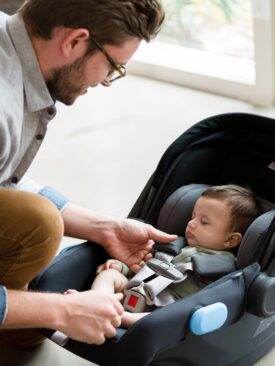

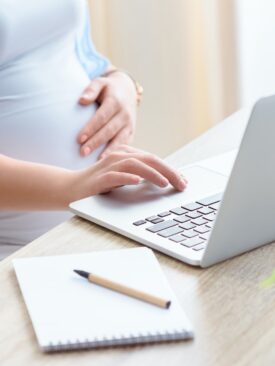
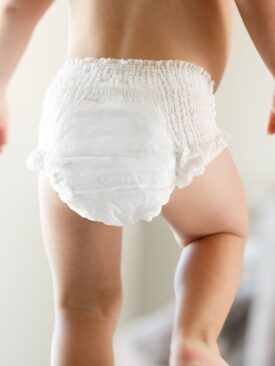
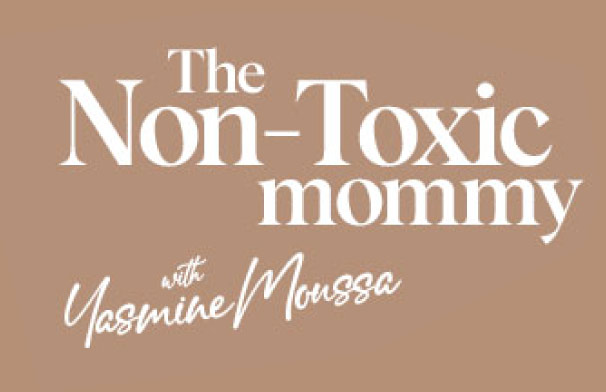
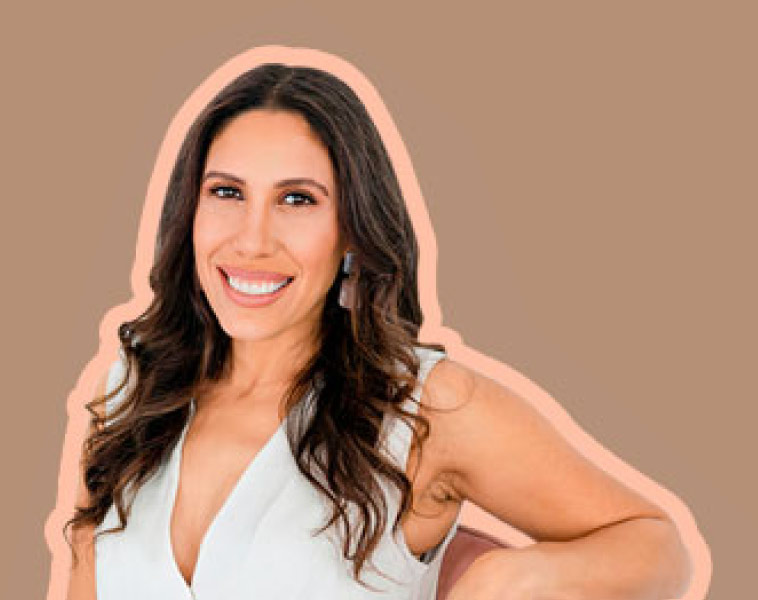

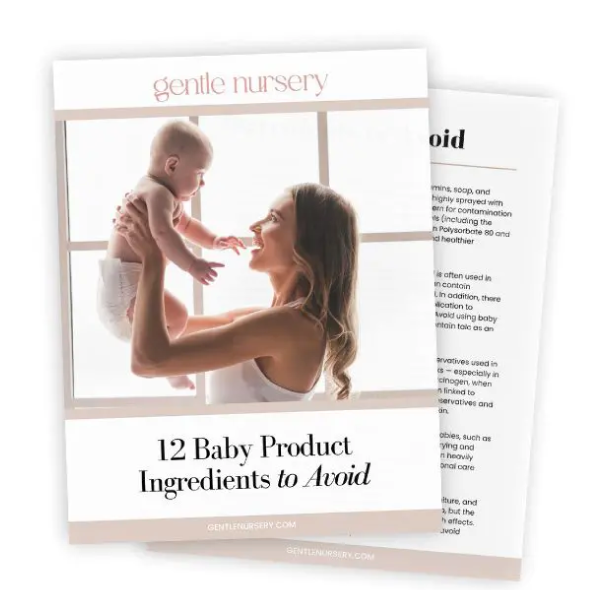
Love your site!!! Want to let you know Ecos by Naty has been having A LOT of manufacturing issues. We just couldn’t take it anymore and switched to a different brand. I’ve contacted them and they already know of their quality issues. They try to work with you and provide you replacement diapers. However, we were still seeing issues. Love their diapers, it’s unfortunate.
We have seen a lot of that across many brands and product types. Thanks for your note, Jenn!
Hi, Just wondering if there was a reason Mummi wasn’t on this list?
Hi Lillian, are they available in the US?
How “green” are Seventh Generation? I know that their other products aren’t as green as they claim just wondering if that is the same for the diapers.
In your post, there is an affiliate to BabieB Bamboo diaper instead of the Naty (Buy Now). Do you recommend that brand?
Hi Ana, that’s incorrect. Thanks for letting me know. I’ll have that updated!
Thank you! Do you recommend 7th generation diapers and wipes? or Earth’s Best TenderCare Chlorine-Free Diapers, Fragrance Free ?
Have you looked into the Pampers Pure Protection diapers? These seem to be new from Pampers and be totally chlorine free per their website.
They looked great but I didn’t list them because they wouldn’t disclose an ingredient to me (the odor absorbing mineral), citing that it was proprietary. My sense is that they’re probably safe to use but I couldn’t say 100% without knowing all of the materials they use.
Are Hello Bello Diapers safe as well too?
Not really. Not a big fan.
Which of these come in a pull-up style for potty training?
Honest and Bambo have them!